DR Acoustics Polynice Power Management/Virtual Ground System by Greg Voth
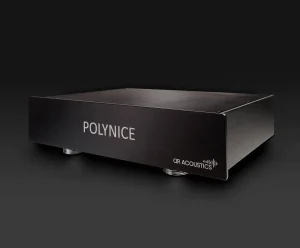

My power conditioner of choice over the two years has been the Puritan Audio PSM156. I’ve been consistently taken with how well this unit performs, so swapping the PSM156 for the Polynice would be interesting. I read a supplied PDF brochure before connecting a mix of four necessary components – PS Audio Gain Cell, 32-bit Memory Player Denafrips Pontus II ladder DAC, and SBS Designs S2 Pro power amp to the Polynice’s four rear power receptacles. Once everything was secured, I plugged the DR Acoustics Red Fire cable into the wall. I decided to break in the Polynice and cable and familiarize myself with their character before connecting the four grounding cables to the components. In addition to the Polynice and Red Fire cable, I included two QSA Jitters, one on the DAC and the other on the Memory Player.
I’ll note here that a retail-purchased unit is said to include a voltmeter, but none was included with the review sample, so I went through the set-up steps with my multimeter to confirm continuity.
 For the next month, I listened to the Polynice Power Management/Virtual Ground System without any of my components connected to its Virtual Ground System to get to know the Polynice by itself, sans grounding. The Polynice provided substantial low frequencies, solid imaging, admirable stage dimension, and air. My Puritan PMS156 and Polynice are of comparable monetary value ($3300 for the Puritan vs $3995 for the Polynice). Will the Polynice Virtual Grounding System tip its hand?
For the next month, I listened to the Polynice Power Management/Virtual Ground System without any of my components connected to its Virtual Ground System to get to know the Polynice by itself, sans grounding. The Polynice provided substantial low frequencies, solid imaging, admirable stage dimension, and air. My Puritan PMS156 and Polynice are of comparable monetary value ($3300 for the Puritan vs $3995 for the Polynice). Will the Polynice Virtual Grounding System tip its hand?
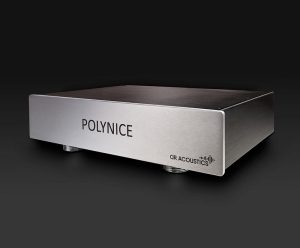
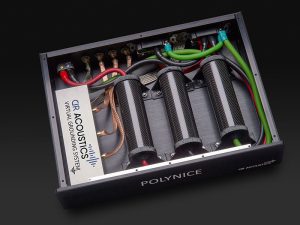
The DR Acoustics Polynice Power Management/Virtual Ground System
 As many of us in the hobby know, power management plays a significant role in the quality of sound we get out of our systems. DR Acoustics came to realize this as well, as they introduced their DR Acoustics Antigone 2.0 Power Management System in 2022 (reviewed in these pages by Dave Thomas); DR A’s new Polynice Power Management/Virtual Ground System is based on the same patented technology as their Antigone. They use three separate quartz filters to eliminate electromechanical noise, EMI, and RFI. The filter system has no electronic parts like capacitors or inductors and is so efficient that it provides a real signal-to-noise ratio improvement to your equipment. The result is a non-current limiting power processor.
As many of us in the hobby know, power management plays a significant role in the quality of sound we get out of our systems. DR Acoustics came to realize this as well, as they introduced their DR Acoustics Antigone 2.0 Power Management System in 2022 (reviewed in these pages by Dave Thomas); DR A’s new Polynice Power Management/Virtual Ground System is based on the same patented technology as their Antigone. They use three separate quartz filters to eliminate electromechanical noise, EMI, and RFI. The filter system has no electronic parts like capacitors or inductors and is so efficient that it provides a real signal-to-noise ratio improvement to your equipment. The result is a non-current limiting power processor.
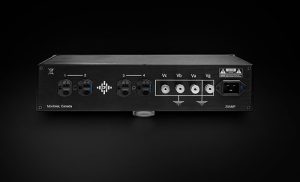
The Polynice is equipped with four quality Rhodium-plated Furutech NCF outlets, and its aluminum chassis is CNC to receive power receptacles with minimal mechanical friction. Developed by DR Acoustics, the new MQCI system uses carbon fiber and ultra-rigid cylinders filled with quartz to eliminate electromagnetic and electro-mechanic noise. As with the Antigone, the Polynice’s internal wiring is cryogenic and assembled by hand in a point-to-point configuration.
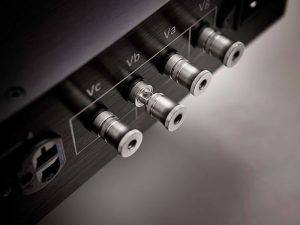
A Month On
 My early-on favorable impression of the DR Acoustics Polynice (sans use of its Virtual Grounding System) did not waver through its first month managing my rig’s power – the Polynice continued to provide a solid and dependable power foundation that I felt at the time (and still do), comparable to the Puritan.
My early-on favorable impression of the DR Acoustics Polynice (sans use of its Virtual Grounding System) did not waver through its first month managing my rig’s power – the Polynice continued to provide a solid and dependable power foundation that I felt at the time (and still do), comparable to the Puritan.
As luck would have it, the wife and I hosted my sister, Pam, and her husband, Tim (Barrall), for the week. Tim has reviewed for Stereo Times and sports a pair of ears I’ve known and trusted for 35+ years. When we both lived in NYC during the 1980s and 1990s, we were fellow travelers in pursuit of audio, hanging out for hours on end in audio shops, going to industry shows together, collecting vinyl and CDs, new and used, and sharing thoughts on audio during daily phone calls. Then, as now, though living in different states, we speak of audio near-daily.
Tim has been present during the many changes in my main rig over the years and knows its character well. He heard the rig managed by the Polynice before introducing the Virtual Grounding System, and we discussed what we had each heard. Mid-week, while Pam and Tim attended to a friend’s artistic needs during a long day in NYC, I thought it the perfect time to connect choice components to the Polynice Virtual Grounding System. With four banana grounding inputs available on the rear of the Polynice, and each recommended for a specific use, I shut down the Polynice and began connecting the four supplied rhodium-plated cables (small spade to banana) as suggested in the Polynice literature found online. In most cases, each of the cables shipped with the Polynice should connect to a component chassis screw – Va (turntable), Vb (preamp), Vc (digital source) and Vg (power amp).
With my preamplifier, I had to crimp the small spade’s forks tighter to hold onto that unit’s very small and short chassis screw. Lastly, my power amplifier sits between my Double Impacts 13 feet away from the rig, so I connected a supplied cable to an amp chassis screw and added a 10-foot speaker cable using a banana-to-banana adapter, which reached the Polynice’s Vg grounding input. This solution should provide an adequate test of the Polynice Virtual Grounding System, albeit sub-optimum.
Listening
That evening, with Tim in-house and the Polynice Virtual Grounding System engaged, I powered up, and we listened to my demo playlist on the 32-bit Memory Player as I took notes on what I heard. The musical presentation with the Polynice Virtual Grounding System activated was quieter and rounder, as though the range of motion of the band had been extended. The piano sounded more authentic and wooden, and the horns appeared more resonant, with more body and personality. Notes came out from greater blackness surrounded by more air, and each instrument appeared to inhabit its space with more personality and verve.
The following day, I left for a doctor’s appointment in the City and asked Tim to take a few notes about Polynice’s handling of songs from my demo playlist. Hours later, I returned to find nicely hand-written pages covering 8 of my select songs. The following are my listening notes and some of Tim’s thoughts.
songs from my demo playlist. Hours later, I returned to find nicely hand-written pages covering 8 of my select songs. The following are my listening notes and some of Tim’s thoughts.
With the Virtual Grounding System connected, Lu and Goods’ Water – H2O, from 2023’s “Connected” release (Richman Music, Inc.) sounded more dimensional, with transients delivering more impact. The bowed bass had more body and drive; the marimba played with more physicality and depth. Tim heard the marimba as “more lively and percussive, with the ethereal guitar much further back on the stage.”
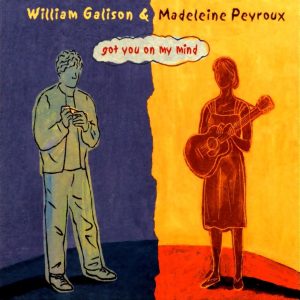 On Heaven To Me, from William Galison and Madeleine Peyroux’s “Got You On My Mind” (2004 Waking Up Music), Tim noted that Will Galison’s harmonica leaned more to the front and the finger plucks on the guitar’s steel strings bore greater detail. Peyroux’s voice appeared more pronounced. The vocal had more body and character, with more nuance detected. Galison’s harp had more air, and the brushes were rounder, with more air and depth. Bass was bolder.
On Heaven To Me, from William Galison and Madeleine Peyroux’s “Got You On My Mind” (2004 Waking Up Music), Tim noted that Will Galison’s harmonica leaned more to the front and the finger plucks on the guitar’s steel strings bore greater detail. Peyroux’s voice appeared more pronounced. The vocal had more body and character, with more nuance detected. Galison’s harp had more air, and the brushes were rounder, with more air and depth. Bass was bolder.
With a play of Shirley Horn’s Where Do You Start, from 1992’s “Here’s to Life” (Verve Records), Horn’s piano had greater body, and her vocals were richer and more captivating. The strings were more relaxed as they came to my ears with more depth and air. Tim commented that Horn’s “vocal and the strings supporting her were lush.”
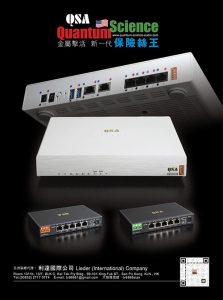 Adam Blackstone’s New Day, from “Legacy – The Instrumental Jawn,” New Day (2023 Bassic Black Entertainment Records / Anderson Music Group / Empire), was rendered with better stage width and depth, with the organ appearing wider. Blackstone’s bass had more drive, and the instrumentation tone was rounder, with nuances more apparent. Tim commented, “This recording had a delightful and engaging mix of instruments, all floating around the speakers.”
Adam Blackstone’s New Day, from “Legacy – The Instrumental Jawn,” New Day (2023 Bassic Black Entertainment Records / Anderson Music Group / Empire), was rendered with better stage width and depth, with the organ appearing wider. Blackstone’s bass had more drive, and the instrumentation tone was rounder, with nuances more apparent. Tim commented, “This recording had a delightful and engaging mix of instruments, all floating around the speakers.”
Next is Abstraction, from Amanda Whiting’s “Lost In Abstraction” (2022 Jazzman Records). We both agreed on this one, as Whiting’s harp strings felt more affluent and percussive, with a greater sense of air, and the bass had a broader reach, particularly in the low register. The drums and cymbals were better separated in the mix; the brushes rendered with better texture and depth, and the cymbals felt warmer, rounder, and better body. The dynamics were better overall, and the recording felt more alive and natural.
 Next, a play of Georgia Cécile’s Bittersweet, from “Only The Lover Sings” (2021 Georgia Cécile / Euan Stevenson), presented a warmer, more affluent, and further nuanced vocal, with the overall presentation more dimensional. Stage depth was improved, and subtleties were more apparent. Tim thought the recording was “captivating and placed perfectly between the speakers, while this closely-miked vocal made for an intimate and heartfelt experience,” adding, “While the instruments were a touch harsh, they were nonetheless very detailed.”
Next, a play of Georgia Cécile’s Bittersweet, from “Only The Lover Sings” (2021 Georgia Cécile / Euan Stevenson), presented a warmer, more affluent, and further nuanced vocal, with the overall presentation more dimensional. Stage depth was improved, and subtleties were more apparent. Tim thought the recording was “captivating and placed perfectly between the speakers, while this closely-miked vocal made for an intimate and heartfelt experience,” adding, “While the instruments were a touch harsh, they were nonetheless very detailed.”
Bring Me the Disco King, a favorite track from David Bowie’s 2003 “Reality” (ISO Columbia), was rendered with better depth, and the piano sounded sharper, more prosperous, and more emotive, with improved attack. The reverb on Bowie’s voice was more apparent, and his annunciation was clearer, with improved stage dimension and air. The bass drum held better body, texture, and depth. Tim commented, “The piano commanded the space with strength and power; the drums also had more power. Bowie’s vocal was more in your face.”
The Wrap
I enjoyed this review of the DR Acoustics Polynice Power Management/Virtual Ground System. By itself, the Polynice proved to be of considerable quality, and utilizing its Virtual Grounding System took clarity and musicality to a higher level.


Specifications: DR Acoustics Polynice Power management/Virtual Ground System with the DR Acoustics Red Fire Shadow Series Power Cable
Price: $3995USD
Contact:
Daniel Robidoux
DR Acoustics
3450 St-Denis, office 124
Montréal QC H2X 3L3
Tel: +1 514-961-5303
Email: drobidoux@dracoustics.com
Web: http://www.dracoustics.com
Features:
• Virtual Grounding System
• DR Soft-mat
• MQCI Noise reduction technology (Micro Quartz Chamber Isolation
System)
• ASSITS Vibration Control Subsystem
• Individual phase filtration system
• Integrated anti-resonance footer
• Rhodium-plated Alpha pure copper receptacles
• Multistage Point to point Wiring (No PCB)
• Cryogenic internal Cabling
• 4 AWG Ultra-pure Copper internal Wire
• No current limiting fuse or breaker
• No Coils
• No Capacitors
• Max 20 Amp
• Max Instantaneous Current 360 Amp
• Max voltage 240V
• Outlets: 4 NEMA 5-2R
• Inlet IEC C-20
• 10 mm face plate available in Silver or Black anodized aluminium
Stereo Times Masthead
Publisher/Founder
Clement Perry
Editor
Dave Thomas
Senior Editors
Frank Alles, Mike Girardi, John Hoffman, Russell Lichter, Terry London, Moreno Mitchell, Paul Szabady, Bill Wells, Mike Wright, Stephen Yan, and Rob Dockery
Current Contributors
David Abramson, Tim Barrall, Dave Allison, Ron Cook, Lewis Dardick, Dan Secula, Don Shaulis, Greg Simmons, Eric Teh, Greg Voth, Richard Willie, Ed Van Winkle, and Rob Dockery
Music Reviewers:
Carlos Sanchez, John Jonczyk, John Sprung and Russell Lichter
Site Management Clement Perry
Ad Designer: Martin Perry





Be the first to comment on: DR Acoustics Polynice Power Management/Virtual Ground System by Greg Voth